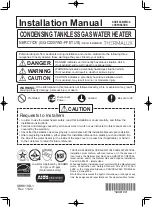
14
14
C
on
tr
ol
s &
In
di
ca
ti
on
s
E.3
Controls
1.
Power: This switch turns the power supply to the
board ‘ON’ or ‘OFF’.
WARNING
WARNING.
TB1 and TB2 120Vac inputs to controller
can remain energized.
2.
Reset: This push button is used to reset the
controller in case of a lockout.
3.
Delay Start: This dial sets the length of the delay, 0 to
60 seconds, before starting the heater. It is intended
to allow the stagger start of multiple heaters
connected to one power service thereby reducing
the maximum current draw. This setting is true for
REMOTE RTC mode only. Under MANUAL, AUTO and
REMOTE SCADA modes there is no delay.
NOTE:
This setting is overridden when operated in REMOTE
SCADA mode by the corresponding Fastrax® RCMS
software parameter.
4.
Post Purge
: This dial sets the length of the delay, 5
seconds to 4 minutes, once the heater is no longer
requested, before stopping the fan. It is intended
to purge the remaining heat and moisture from the
combustion and duct system. This setting is true for
all modes.
5.
RTC Time
: (RTC stands for Rail Traffic Control dispatch)
This dial limits the run time between 20 minutes to 4
hours, when requested by RTC dispatcher, and with
the RTC SW switch ON, and the heater is in REMOTE
RTC mode. When the RTC request exceeds the time
limit, the heater turns off, and the run indication is
maintained as long as the heater is requested.
Timer is reset once the RTC request is removed. RTC
can then request the heater for another cycle.
It is intended to save fuel by avoiding unnecessary
heater operation by the dispatcher. This setting is
true for RTC MODE only. Under MANUAL, AUTO, and
REMOTE SCADA modes there is no limit.
6.
RTC SW: This switch enables the RTC TIME function
when in the ON position. When switched OFF, RTC
TIME is disabled and the heater runs as long as
requested.
7.
JUMPER, JP1: Used to configure controller parameters.
E.4
Indications
1.
There are a number of status LEDs on the controller
intended to aid the user’s understanding of the
heater state of operation. See Table 6 - Controller
LED Descriptions for full description.
NOTE:
With the exception of the communications TD, RD, and
TX LED’s. Solid green, solid green with a red pulse, or
yellow LED’s indicates normal status. Solid red and
alternating LED’s indicate a failure. This is true for the
controller only, not the EMS module.
2.
Refer to Section F - Troubleshooting for explanation of
problem condition LED codes.
3.
The LEDs listed can be found on the controller from
top left to bottom right on the board.
Table 1 – Controller LED Descriptions
LED Name
Description
State
Indication
TD, RD, TX
RS-485
communications
TD, RD on and
pulsing
TX off and pulsing
Heater in REMOTE SCADA mode.
TX off
TD and RD on
Heater in LOCAL AUTO mode.
TD, TX off and
pulsing
RD on
8N1 COM communications mode.
Status
Processor status
Solid green with a
red pulse
Normal operation.
Alternating red and
green
FSR failure alarm. Aggressive retry mode in process.
Solid red
Failure alarm.
Note any alternating LEDs and refer to Section F - Troubleshooting.
Controller must be reset.
Solid green or off
Processor has stopped functioning.
ENABLE
Heater enable
On
Mode selector switch is either in MANUAL or REMOTE/AUTO
position.
Heater can be started in AUTO REMOTE RTC or REMOTE SCADA
modes.
Off
Mode selector switch is in OFF position. Heater is in OFF mode and
will not start.
FSR CHECK
Flame Safety
Relay/DSI check
On
Gas valve energized. Used to confirm correct operation of DSI.
Alternating
The DSI did not energized the main gas solenoid valves when
expected.
Summary of Contents for HELLFIRE 400
Page 26: ...26 26 Installation Figure 2 140 Clearance Figure 3 155 Clearance...
Page 27: ...27 27 Installation Figure 4 Clearance Turned 90 Degrees...
Page 39: ...39 39 THERMON HEATING SYSTEMS INC Heater Specifications...
Page 40: ...40 40 THERMON HEATING SYSTEMS INC Heater Specifications...
Page 41: ...41 41 CCI THERMAL TECHNOLOGIES INC Heater Specifications...
Page 42: ...42 42 THERMON HEATING SYSTEMS INC Heater Specifications...
Page 54: ...54 54 NOTES...
Page 55: ...55 55 NOTES...















































